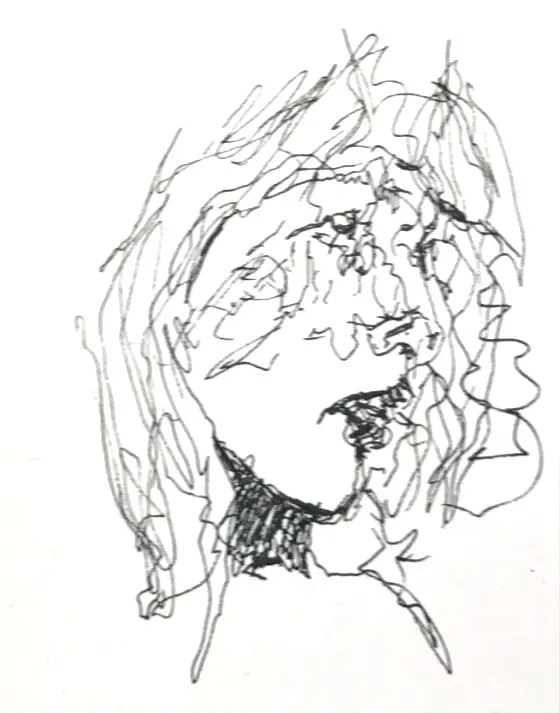Many art lovers and people who learn to draw find themselves producing stiff or robotic looking drawings, which lack character. This is often due to an over-reliance on the use of guidelines, rulers, straightedges. This frequently results in appearance dull and lifeless-looking images.
Drawing with no guidelines? There are many simple approaches you can employ to draw without using underlying proportions or shapes. Gestural drawing and timed sketching are effective techniques that artists can use to produce spontaneous and expressive drawings without guidelines.
This post will outline several simple methods you can use to create expressive sketches in pencil, graphite, or charcoal.
The article will include several practical techniques to begin to try immediately in your drawing working from observation or memory.
Related Posts:
- What are the Basics of Sketching?
- Should You Draw Outlines?
- Sketching vs. Drawing: What's the difference?
- How to Make Your Drawings Look less Stiff
Gestural Drawing Without Guidelines
The advantage of gestural sketching is that it allows you to render directly without the need for guidelines.
When produced immediately and directly, Gestural sketching will enable the artist to create expressive free drawings quickly applying non-mechanical methods.
Taking the example of life sketching or figure work (which is one of the subjects artists use to apply these methods). You can practice working rapidly to create sketches and drawing without measuring or rulers.
Spontaneity is the key to producing drawings using this technique. Hold the pencil loosely in different positions. Gripping the pencil in alternative ways will help you create gestural marks devoid of guidelines. Experiment sketching from the elbow and shoulder will also enable you to work in a far more intuitive manner.
When commencing a portrait sketch, I would advise you to sketch using a vertical surface. A drawing board mounted onto an easel will immediately force you to sketch without resting your arm and wrist.
If drawing directly from observation, you will immediately gain the advantage of your ability to compare your drawing and subject seamlessly as you draw.
Drawing Under Timed Conditions
Experimenting with your speed sketching and employing alternative methods is probably the most effective way to discard the need for guidelines during the initial stages of art.
One method which is taught widely in art schools is timed sketching. Working under timed conditions immediately places pressure on the artist to sketch lines rapidly and remove any misconceptions about representing a realistic pictorial representation of the subject before them.
To create images using this process, it is advisable to sketch using a staged approach.
Beginning with short timed sketching directly from observation is an excellent way to start drawing without—for example, a short one-minute sketch and then progressing onto five-minute or ten-minute tasks.
If you want to draw, timed sketches can also be produced using an imaginative context. For example, creating an imaginative design or preliminary artwork under set conditions.
Learning How to Draw Figures
Learning how to draw the human form for many artists involves figuring out the human form's proportions and anatomy.
However, figure sketching can be generated instantly from observation using a variety of techniques and media.
Working directly could, for example, take the form of a contour or an outline sketch. Observing the human form from observation and representing the outline of the subject is a good option if you are looking to experiment with your artwork's appearance.
Blind sketching is another alternative for artists looking to create artwork free of guideline proportions and measuring.
On the way to becoming better at art, rendering and blind sketching without guidelines are produced with the main focus directed towards keeping your eyes on your sketch's subject matter. Making sure you are not tempted to glance at your work as you are creating it.
Blind sketches create interesting but highly experimental techniques that exclude drawn guidelines in any preliminary sense.
Portrait Sketches Without Guidelines
Many of the sketching methods outlined in the previous paragraphs can also be updated to create portraits and the head and face.
Continuous line sketch created directly onto the page either from direct observation from the subject you intend to sketch or from a flat image such as a photograph, or a secondary source reference is an excellent way to create artwork without guidelines.
First, take the subject or image you want to represent and study and learn the individual's proportions, details, and character.
I would suggest that you begin working from the top of the page and progress down the page as you are sketching.
Key Points: Continuous Line Techniques
- Learn to Work Intuitively
- Get better at drawing basic shapes
- Keep the pencil or pen on the page
- Careful observation is key to continuous line sketching.
- Add as much detail as possible to the different features of the image.
- Practice continuous line drawing.
- Use a variety of art media such as pen, pencil, and charcoal or graphite sticks.
Drawings Which Use Guidelines
Many images can be drawn that use guidelines and drafting equipment using a ruler and set squares. Technical images and diagrams use lines to create exact proportions. These particular kinds of diagrams and images rely on guidelines for accuracy.
Learn to Draw Still Life
Still life art without any underlying guidelines tends to look random and experimental in appearance and is worth attempting.





